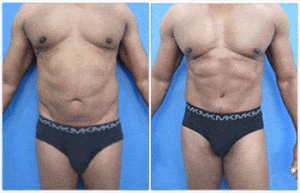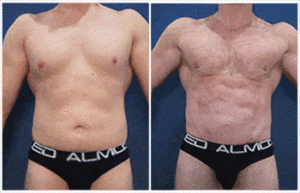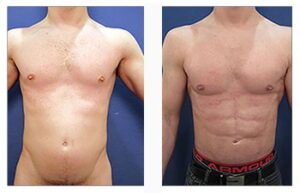What Are Puffy Nipples?
Puffy nipples refer to enlarged or protruding nipples that lack defined borders. The areola, or the pigmented skin surrounding the nipple, may also appear swollen or puffy. This occurs when excess fatty tissue accumulates around the areola region, causing it to bulge outward. With prominent nipples, the nipple and areola take on a swollen, inflamed appearance compared to a normal flat or slightly raised nipple contour.
The prominent tissue can be soft and tender to the touch. In severe cases, the enlarged nipple and areola can be quite pronounced. Prominent nipples tend to be caused by excess skin, fat, and breast tissue that distorts the natural shape of the nipple area. The culprit of puffy nipples is an increase in Testosterone levels that is typically due to a medical condition. When the gland and fat in the area of the prominent nipple grow, even aggressive chest exercises that will increase the bulk of the pectoral muscle will not help with this feminized appearance attributed to prominent nipples.
The treatment plan is twofold and either focused on lowering testosterone levels through a healthy diet and exercise or through surgical removal of the breast gland and fat causing breast enlargement.

Anatomy of the Nipple
The nipple contains small mammary glands that connect to lactiferous ducts beneath the areola. This glandular tissue and duct system is what enables the flow and release of breast milk during lactation and breastfeeding. The glands and ducts are surrounded by fatty tissue and fibrous connective tissue that provide padding, structure, and support to the nipple region. When excess fat develops in the connective tissue surrounding the glands, ducts, and general nipple anatomy, the tissue expands outward. This expansion of the deeper breast fat pads causes the nipple ducts, areola, and skin to protrude, resulting in a puffy appearance.
What Causes Puffy Nipples?
There are several potential causes that can contribute to puffy or enlarged nipples:
Genetics
Some cases of puffy nipples are linked to hereditary factors. Breast shape and anatomy are partially determined by genetics. The amount of fatty tissue distributed across the breasts, as well as nipple size and shape, can be inherited traits passed down through families. Those who have an inherent predisposition for increased fatty breast tissue or certain breast contours may be more prone to developing prominent nipples.

Excess Fatty Tissue
Extra fatty tissue around the nipple region leads to puffiness and swelling. Individuals who have higher overall body fat percentages tend to have more fatty breast tissue, which can cause a protruding appearance of the nipple and areola region. Those who are overweight or obese may be predisposed to puffy nipples due to excess accumulated fat cells throughout the breasts.
Hormonal Imbalances
Hormone changes related to puberty, menopause, or disorders like hypothyroidism can increase breast fatty tissue and breast duct growth, potentially leading to puffy nipples. The hormonal fluctuations cause hyperplasia (overgrowth) of the milk ducts as well as expansion of the surrounding connective tissue and fat pads. For example, the surge of estrogen during puberty stimulates breast tissue growth. Hormonal disruptions later in life can also impact breast cell growth and fat storage pattern
Chafing
Skin irritation from exercise and chafing against clothing, especially vigorous physical activity like running, can sometimes inflame the nipple tissue. This leads to swelling and irritation that gives the appearance of temporarily puffy nipples. Finding properly fitted athletic wear and protecting the nipples can help prevent this mechanical irritation.

How to Get Rid of Prominent Nipples
Can Puffy Nipples be Fixed?
In many cases, puffy nipples can be reduced and fixed through a variety of approaches, depending on the severity and cause. Simple lifestyle changes like diet, exercise, and skincare can improve very mild cases of puffiness. Topical creams may help if hormonal fluctuations are the cause.
In more significant cases, medications, injections, or plastic surgery procedures can effectively reduce enlarged, protruding nipples and return them to a natural, flatter appearance. The right treatment options depend on examining the underlying mechanism causing the puffy nipples for each individual. A combination approach is usually required for the best aesthetic results.
What Doctors Treat Puffy Nipples?
A plastic surgeon or cosmetic dermatologist is the specialist who most commonly treats puffy nipples. They can visually examine and assess the degree of puffiness and determine the appropriate treatment options. An endocrinologist may need to be consulted to evaluate potential hormone level abnormalities contributing to the breast changes. Dermatologists can also assess potential skin inflammation issues causing temporary swelling. Depending on the severity and cause, a team approach by different specialists may be required to reduce prominent nipples and return the nipple contour to normal.
Can Big Nipples be Fixed?
Yes, in most cases large or massively enlarged nipples that appear puffy and swollen can be reduced through procedures like surgical nipple reduction and liposuction. The excess protruding tissue, including fat deposits, skin, ducts, and glands can be excised and re-contoured to effectively reshape and resize the nipple area to create the desired look. After recovery, the nipples are smaller with a defined border and no longer have a swollen puffy appearance.
Do Men Get Puffy Nipples?
Prominent nipples can occur in both men and women for similar reasons, although the underlying causes may differ. In men, a common cause of a puffy chest and enlarged nipples is gynecomastia or increased breast tissue. This condition is frequently associated with puberty due to hormonal fluctuations. Excess glandular breast tissue in combination with fatty tissue accumulates around the areola, causing the characteristic puffy appearance. Prominent nipples can persist even after the gynecomastia resolves if excess fat remains.

Lifestyle Changes to Fix Puffy Nipples
Making certain proactive lifestyle adjustments may help reduce puffiness:
Exercise
Regular cardiovascular exercise along with strength training that burns overall body fat can slim and flatten puffy nipples. Building muscle mass in the chest region through targeted exercises like pushups, bench presses, and flies can make the area appear tighter and more contoured. Reducing overall body fat percentage and enhancing muscular definition helps create a flatter, more masculine chest.
Diet
Eating a nutritious, low-fat, high-protein diet supports lean muscle growth in the chest while also reducing fatty tissue associated with puffy nipples. Limiting refined sugars and optimizing nutrients through whole foods helps control fat accumulation and balance hormones that influence breast tissue.
Supplements
For men with gynecomastia seeking to control estrogen levels and improve testosterone, supplements containing beneficial ingredients like chrysin, zinc, magnesium, vitamin B6, and DIM may provide support. These can help mitigate hormone factors leading to breast tissue overgrowth and puffy nipples. Always consult a doctor before starting supplementation.
Liposuction for Puffy Nipples
Liposuction is a popular plastic surgery procedure that removes excess fat deposits from targeted areas like the breasts and chest through small incisions. This can be an effective approach to reducing puffy nipples by directly suctioning out the fatty breast tissue that is causing the protruding appearance. It provides immediate improvement by debulking the fat pads surrounding the nipple. Combined with excision techniques, the skin tightens up after healing, creating a natural flat contour.
Plastic Surgery for Puffy Nipples
For significant reduction of enlarged puffy nipples, plastic surgeons may perform excisional surgical procedures such as:
- Benelli lift (donut mastopexy) – Removes a circular ring of tissue around the perimeter of the areola to reduce the hyperpigmented skin and tighten the area.
- Nipple reduction – The protruding enlarged nipple ducts, glands, fat, and skin are excised and the tissue is reconstructed to yield a smaller, refined nipple.
- Gynecomastia surgery – Excises excessive glandular breast tissue and fat through techniques like subcutaneous mastectomy and liposuction for male chest contouring.
These can all effectively reshape enlarged puffy nipples by removing the excess tissue and creating a more natural, proportional, defined chest and nipple appearance.
FAQs About Puffy Nipples
How long does it take for puffy nipples to go away? With consistent lifestyle changes like weight loss, exercise, and diet, mild puffiness may gradually improve over several weeks or months. Surgical excision of tissue produces immediate visible results of reduction. Post-surgical swelling subsides within weeks.
Do push-ups help puffy nipples? While not a cure, regularly building chest muscle mass through bodyweight exercises like pushups and chest presses can make mild puffy nipples less noticeable. This enhances muscular definition. Severe puffy nipples require medical treatment.
At what age do puffy nipples go away? Puffy nipples related to the hormonal changes of puberty often resolve naturally by the late teens or early 20s as hormones regulate for most males. Some residual puffiness can persist. Older adult men may develop puffy nipples related to aging hormonal shifts or weight gain
Medical References About Puffy Nipples:
https://www.ncbi.nlm.nih.gov/books/NBK448191/ https://www.ncbi.nlm.nih.gov/books/NBK532266/ https://www.ncbi.nlm.nih.gov/pmc/articles/PMC2891926/

